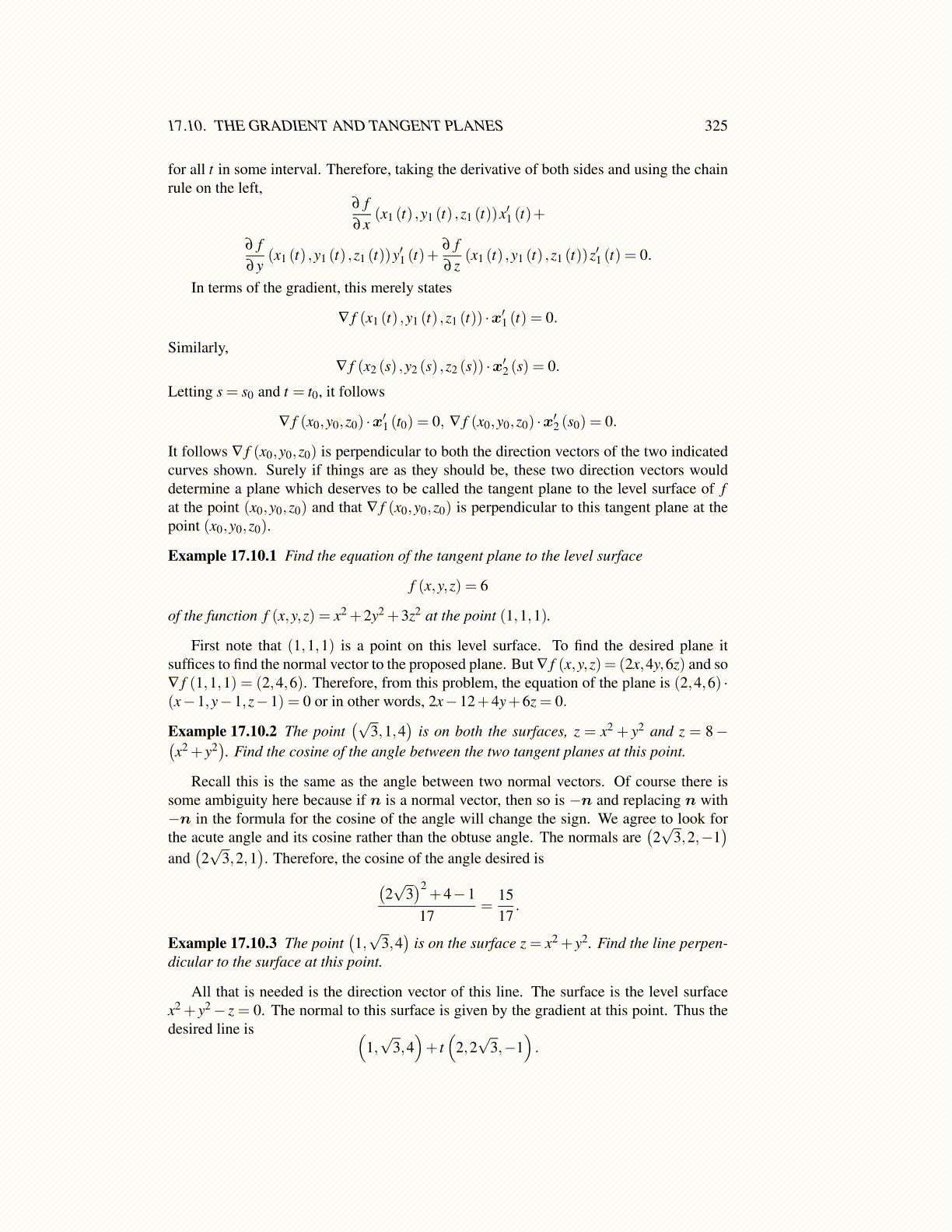
17.10. THE GRADIENT AND TANGENT PLANES 325
for all t in some interval. Therefore, taking the derivative of both sides and using the chainrule on the left,
∂ f∂x
(x1 (t) ,y1 (t) ,z1 (t))x′1 (t)+
∂ f∂y
(x1 (t) ,y1 (t) ,z1 (t))y′1 (t)+∂ f∂ z
(x1 (t) ,y1 (t) ,z1 (t))z′1 (t) = 0.
In terms of the gradient, this merely states
∇ f (x1 (t) ,y1 (t) ,z1 (t)) ·x′1 (t) = 0.
Similarly,∇ f (x2 (s) ,y2 (s) ,z2 (s)) ·x′2 (s) = 0.
Letting s = s0 and t = t0, it follows
∇ f (x0,y0,z0) ·x′1 (t0) = 0, ∇ f (x0,y0,z0) ·x′2 (s0) = 0.
It follows ∇ f (x0,y0,z0) is perpendicular to both the direction vectors of the two indicatedcurves shown. Surely if things are as they should be, these two direction vectors woulddetermine a plane which deserves to be called the tangent plane to the level surface of fat the point (x0,y0,z0) and that ∇ f (x0,y0,z0) is perpendicular to this tangent plane at thepoint (x0,y0,z0).
Example 17.10.1 Find the equation of the tangent plane to the level surface
f (x,y,z) = 6
of the function f (x,y,z) = x2 +2y2 +3z2 at the point (1,1,1).
First note that (1,1,1) is a point on this level surface. To find the desired plane itsuffices to find the normal vector to the proposed plane. But ∇ f (x,y,z) = (2x,4y,6z) and so∇ f (1,1,1) = (2,4,6). Therefore, from this problem, the equation of the plane is (2,4,6) ·(x−1,y−1,z−1) = 0 or in other words, 2x−12+4y+6z = 0.
Example 17.10.2 The point(√
3,1,4)
is on both the surfaces, z = x2 + y2 and z = 8−(x2 + y2
). Find the cosine of the angle between the two tangent planes at this point.
Recall this is the same as the angle between two normal vectors. Of course there issome ambiguity here because if n is a normal vector, then so is −n and replacing n with−n in the formula for the cosine of the angle will change the sign. We agree to look forthe acute angle and its cosine rather than the obtuse angle. The normals are
(2√
3,2,−1)
and(2√
3,2,1). Therefore, the cosine of the angle desired is(
2√
3)2
+4−117
=1517
.
Example 17.10.3 The point(1,√
3,4)
is on the surface z = x2 + y2. Find the line perpen-dicular to the surface at this point.
All that is needed is the direction vector of this line. The surface is the level surfacex2 + y2− z = 0. The normal to this surface is given by the gradient at this point. Thus thedesired line is (
1,√
3,4)+ t(
2,2√
3,−1).